List of Authors
>>About this blog
Recent blog post
|
[Nojinya]
December 31, 2015 09:00
As announced in the blog post on December 3 (/archive/2015/12/post-2910.html), construction work for major renovations in the Heisei era (rebuilding of shrine office, etc.) has been underway since November. The grounds were surrounded by a white board with dumps and construction equipment, so I was worried that new year worshipping would not be able to go as it was, but last week, temporary construction was suspended and visitors could enter and exit from the main gate Was. 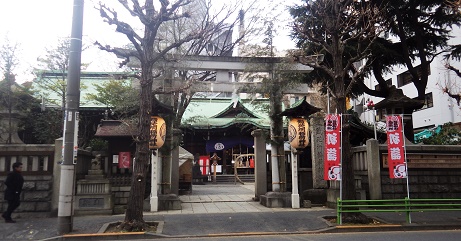 In front of main hall, Chinowa for New Year's Eve exorcism has already been prepared, and the part where shrine office was located remains surrounded by a white board, but as usual, this New Year seems to be safe. In front of main hall, Chinowa for New Year's Eve exorcism has already been prepared, and the part where shrine office was located remains surrounded by a white board, but as usual, this New Year seems to be safe.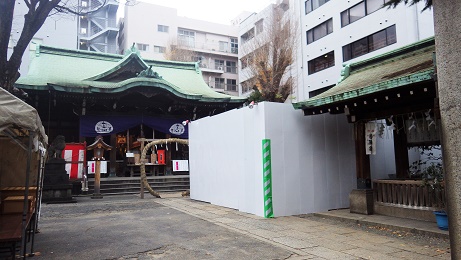
I would like to inform you as soon as possible because I thought it was a concern to our blog readers.
Added: The Kannaka Misogi (Kannaka Bathing Tournament) on January 10 (Sun) seems to be held at Tepposu Park from 11:00 am. 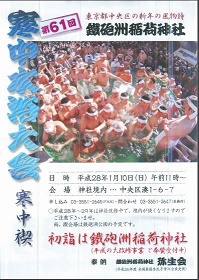 [Tepposhu Inari Shrine] [Tepposhu Inari Shrine]
Location 1-6-7 Minato, Chuo-ku, 104-0043, Japan
Phone: 03-3551-2647
Access Get off at the Tokyo bus "Higashi 15" and Edo bus "South circulation" gunshot stop. Chuo-ku community cycle "B01 gunshot children's park" cycle port soba.
[Nojinya]
December 30, 2015 14:00
During this time, Western Europe is a beautiful season with decorations to celebrate Christmas and New Year. I think that there are many people who usually visit Paris at the end of the year, but this year I am a little worried about terrorism. This is a story about searching for France in Chuo-ku. In Chuo-ku, there are few shops and facilities related to France, including Plantan Ginza, but today, one of them is MMM (Maison des Musées du Monde (Maison de Musées du Monde) in Ginza. I visited.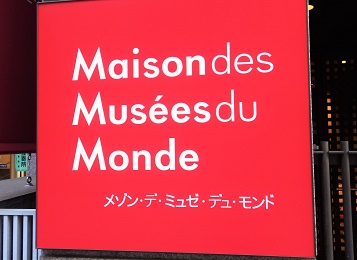
This is a cultural facility that DNP (Dainippon Printing) has been conducting as a cultural activity since 2003, providing information on museums (art galleries and museums) and displaying and selling official museum goods. Since 2013, we have been expanding our activities not only in France but also in Europe and the world, based on the concept of "living art and design around the world."
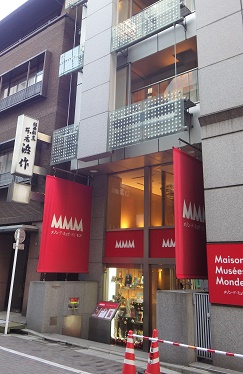
The location is near Suzuran Street on the west side of Chuo-dori and Kojunsha Street. Nearby is Kojunsha, which was established in 1880 by Keio founder Yukichi Fukuzawa as Japan's oldest social club, and has many restaurants. "Hamasaku" from Kansai Kappo cuisine, introduced by correspondent CAM in the Snow Series (7) (/archive/2015/12/post-2972.html) on December 26, is also next to it.
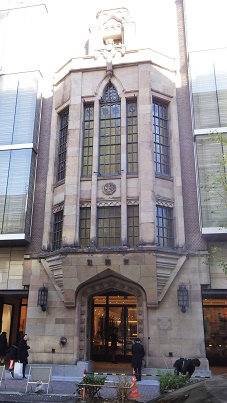 [Kojun Building] ⇒The facade of Kojunsha remains as part of the building. [Kojun Building] ⇒The facade of Kojunsha remains as part of the building.
At the entrance of the glass-walled building, Akachi has a stylish design with a signature of the three letters of MMM. 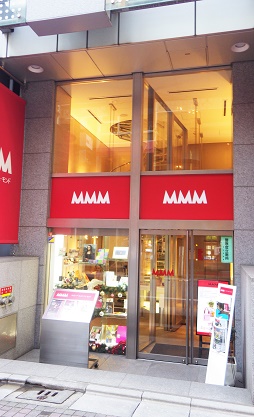 I'll go inside. The first and second floors are museum shops, providing information on museums in Europe, mainly in Louvre and France, as well as exhibiting and selling museum goods. It's not a very large space, but there are French museums such as Louvre (Paris), Orsée (Paris), Versailles (Paris), Luxembourg Museum (Paris), Carvee Museum (Avignon), as well as the Clai Centre (Bern), the British Museum (London), the Tate Gallery (London), and the Vienna Museum of Fine Arts and Museum of Fine Arts in Vienna in the European Centre (Venna. I'll go inside. The first and second floors are museum shops, providing information on museums in Europe, mainly in Louvre and France, as well as exhibiting and selling museum goods. It's not a very large space, but there are French museums such as Louvre (Paris), Orsée (Paris), Versailles (Paris), Luxembourg Museum (Paris), Carvee Museum (Avignon), as well as the Clai Centre (Bern), the British Museum (London), the Tate Gallery (London), and the Vienna Museum of Fine Arts and Museum of Fine Arts in Vienna in the European Centre (Venna.
When you climb up to the third floor by elevator, you will be separated from the museum because of the art space, and there will be a special exhibition on the theme of graphic art and design. We were just holding the "Christmas Table Goods Special" (until December 25). I couldn't take photos, so I'm sorry that I couldn't tell the blog readers about it, but it was a relaxing exhibition that reflected the seasonal atmosphere.
Next, I will go to the MMM library on the first basement floor.
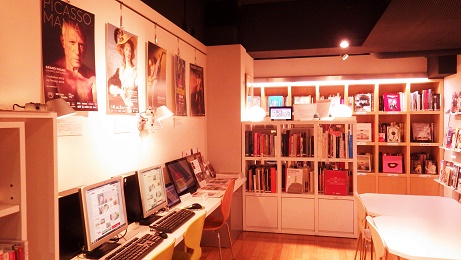
[MMM Library (1st basement floor)] ⇒This shooting has been approved by MMM.
While other spaces are exhibited and sold, this is a space where you can view exhibition catalogs of museums around the world and art-related materials stored by MMM. It seems to be useful to look at local art information before actually going to Paris or Europe, such as slowly looking at materials at the table or browsing multimedia software using a personal computer.
There is Ginza Graphic Gallery (ggg) along the adjacent Kojunsha Street, but it is currently closed for renovation and is scheduled to open on April 15. 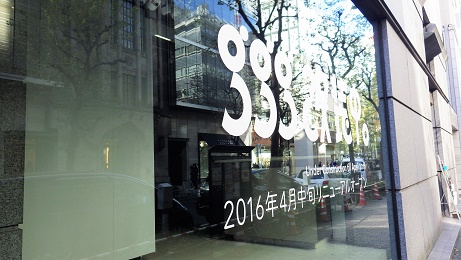 This is not limited to Europe such as France, but it is a place to disseminate graphic design, but it seems that activities in cooperation with MMM will also be carried out when reopening. This is not limited to Europe such as France, but it is a place to disseminate graphic design, but it seems that activities in cooperation with MMM will also be carried out when reopening.
【MMM(Maison des Musées du Monde)】
Location 7-7-4 Ginza, Chuo-ku, 104-0061, Japan (DNP Ginza Annex)
Phone: 03-3574-2380
Business hours From 11:00 to 19:00 (Sunday holiday)
Admission fee: Free of charge
[Nojinya]
December 29, 2015 16:00
Sunday, November 1st. The whole museum 2015 will be held in Chuo-ku, and 26 correspondents of the Chuo-ku Tourism Association, including the second "Chufuchu-Ii", will board a free patrol bus. And served as a guide for the city with a microphone in one hand. On the day of the event, there were various incidents such as adjustment of the number of passengers and time adjustment of the operation interval, and heavy traffic congestion due to a demonstration march in the Ginza area, but the task of "telling customers the charm of Chuo-ku" is a great opportunity for our correspondent to show the results of our usual study.
While on a free patrol bus clockwise, depart from the bus platform in Higashinihombashi to head to the Hamacho bus platform and turn left. One of the customers said, "Is it the name of a woman by passing Miyuki?" A simple question is asked. 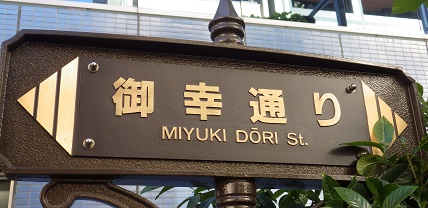 On the road name information board outside the window, "Miyuki-dori (MIYUKI DORI)" is written, and I often hear the name "Miyuki" (although there are characters such as Miyuki and Miyuki) in the female name, popular manga There was also a protagonist! On the road name information board outside the window, "Miyuki-dori (MIYUKI DORI)" is written, and I often hear the name "Miyuki" (although there are characters such as Miyuki and Miyuki) in the female name, popular manga There was also a protagonist!
If you examine the kanji character "Miyuki" in a dictionary, it reads "Miyuki, Goko, Gyoko" and says it has the same meaning as "Yukiyuki" in The Tale of Genji and history textbooks. If so, is this "Miyuki-dori" also the street where His Majesty the Emperor passed? However, if it is Gyoko-dori, which connects the Imperial Palace Square in Marunouchi to the front of Tokyo Station, it will be a street when you take a train from Tokyo Station. I guess, but when it comes to Higashinihombashi, it will be "a little far from the Imperial Palace, but why?"
The reason was at the Rinko Monument next to the bus stop in Higashinihombashi. Before the war, the location where Nihonbashi Junior High School is currently built was Chiyoda Hirone Elementary School (founded in 1877, closed in 1945).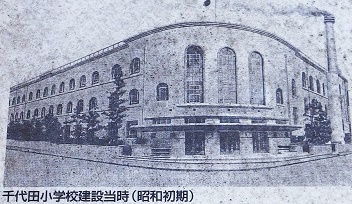
[Chiyoda Hirone Elementary School in the early Showa era (from the Chuo-ku Board of Education explained version)]
In 1923, Tokyo was hit by the Great Kanto Earthquake, and many areas, including Chiyoda Hirone Elementary School, became burnt fields. Chiyoda Hirone Elementary School was completed in December 1929 with a non-combustible structure of reinforced concrete as a reconstruction elementary school through the earthquake disaster recovery project, but visited the Imperial capital where His Majesty the Emperor revived in March 1930 the following year At the time, it seems that the car was stopped near the school and the monument was stopped at the school for a break and the name of the memorial.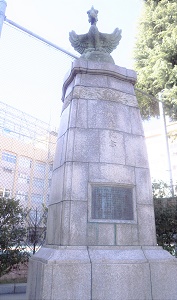
[Rinyuki Monument]
By the way, speaking of "MIYUKI DORI" in Chuo-ku, there is another famous "Miyuki-dori" in Ginza. While MIYUKI DORI of Higashinihombashi is kanji, it is written in hiragana, but this street that connects Shimbashi Enbujo and Hibiya Park and runs through Ginza 5-6 chome in parallel with Harumi-dori St. It was famous as a sacred place for the Miyuki tribe. Shortly before the start of the Tokyo Olympics in 1964, a social phenomenon in which young people with unique fashion that slightly broke the eyebrows hang out and walked around Miyuki Street was called the "Miyuki tribe". Today, as you can see, it is gaining popularity as a gorgeous street lined with brand shops. 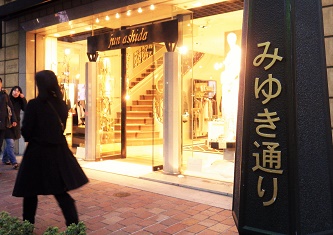 Of course, "Miyuki-dori" in Ginza also comes from "Yuki (= Miyuki)", and this is the road that was passed when Emperor Meiji went to Naval Academy, Naval University, Hamarikyu, etc. in Tsukiji. Of course, "Miyuki-dori" in Ginza also comes from "Yuki (= Miyuki)", and this is the road that was passed when Emperor Meiji went to Naval Academy, Naval University, Hamarikyu, etc. in Tsukiji.
[Miyuki Street]
Location From 2-2 Higashi Nihonbashi, Chuo-ku to 2-10 Higashi Nihonbashi.
[Rinyuki Monument]
Location 1-10-1, Higashi-Nihonbashi, Chuo-ku, 103-0004, Japan (Nihonbashi Junior High School Hamacho Riverside Street)
[Miyuki Street]
Location From 5-1 Ginza, Chuo-ku to 6-4 Ginza.
[Nojinya]
December 29, 2015 09:00
More than a week  before before  the 92nd Hakone Ekiden Main Event of New Year's Day. There is a sign saying "Notice of Traffic Regulation" on Kajibashi Street, which tells you that this will be the Hakone Ekiden course on January 3 of the New Year. the 92nd Hakone Ekiden Main Event of New Year's Day. There is a sign saying "Notice of Traffic Regulation" on Kajibashi Street, which tells you that this will be the Hakone Ekiden course on January 3 of the New Year.  On the outbound route, start in front of the Yomiuri Shimbun headquarters in Otemachi, go straight south on Hibiya Street in Chiyoda-ku, but the last 10th ward on January 3 runs in Chuo-ku. In this way, Hakone Ekiden is a big event of the New Year, but in addition to running in Chuo-ku in the last ward, this race, in fact, has a deep connection with Chuo-ku. On the outbound route, start in front of the Yomiuri Shimbun headquarters in Otemachi, go straight south on Hibiya Street in Chiyoda-ku, but the last 10th ward on January 3 runs in Chuo-ku. In this way, Hakone Ekiden is a big event of the New Year, but in addition to running in Chuo-ku in the last ward, this race, in fact, has a deep connection with Chuo-ku.
Currently, the start / goal point is Otemachi, where the Yomiuri Shimbun headquarters is located, but from the postwar period until 1971, the headquarters of the Yomiuri Shimbun was in Ginza (currently the place   where Plantan Ginza is located), Ginza in Chuo-ku was exactly the start / goal of Hakone Ekiden. where Plantan Ginza is located), Ginza in Chuo-ku was exactly the start / goal of Hakone Ekiden.
Unfortunately, among the 21 teams participating this year, there is no university in Chuo-ku, but three of them are universities closely related to Chuo-ku in history.
One is Juntendo University. This university currently has campuses in Hongo and Sakura (Chiba Prefecture), but in 1838 (Tenpo 9), Taizen Sato founded Wada Juku in Yagenbori (currently Higashinihombashi) where he studied Dutch medicine. It is the origin.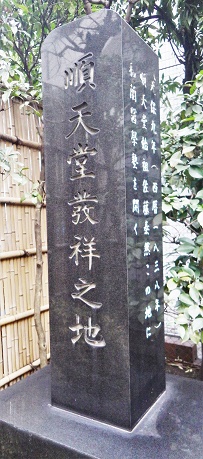
[The Monument of the birthplace of Juntendo in Yagenbori]
The second school is Chuo Gakuin. This is currently headquartered in Abiko City (Chiba Prefecture), but its origin is Nihonbashi Simple Commercial Night School, which was established in Shinkawa in 1900. After that, Nihonbashi Simple Commercial Night School became a Central Commercial School and Chuo Commerce Junior College, and junior colleges were abolished in 2000, but it is Chuo Gakuin University that participated this time.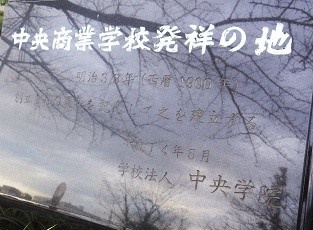
[Monument of the birthplace of Chuo Commercial School (Chuo Gakuin) in Shinkawa Park]
The third school is Aoyama Gakuin, who won last year. The current headquarters is also located in Shibuya, but its origins are Kogaku Gakusha, which was established in 1878 by Julius Sober in Tsukiji Akashicho. Kokyo Gakusha later merged with Azabu Women's Elementary School (later relocated to Akashicho to become a coastal girls' school) and Mikai Shin School in Yokohama Yamate, and became Aoyama Gakuin after going through Tokyo English School and Tokyo Eiwa School. 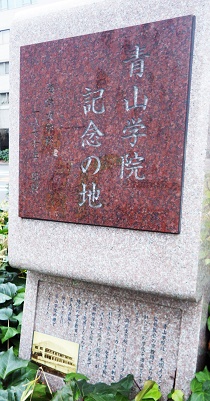 [Aoyama Gakuin Memorial Land in Akashicho] Monument [Aoyama Gakuin Memorial Land in Akashicho] Monument
The anchor runners who climbed Hibiya-dori, the 10th ward of the return trip on January 3, turn right at Baba Sanmon who climbed Hibiya-dori, the 10th ward of the return trip on January 3, turn right at Baba Sanmon  (Marunouchi, Chiyoda-ku) and enter Kajibashi-dori. After crossing (Marunouchi, Chiyoda-ku) and enter Kajibashi-dori. After crossing  the Shinkansen guard and Sotobori-dori St. and entering Chuo-ku, turn left in the Shinkansen guard and Sotobori-dori St. and entering Chuo-ku, turn left in  front of Tokyo Square Garden, enter Chuo-dori, cross Nihonbashi and front of Tokyo Square Garden, enter Chuo-dori, cross Nihonbashi and run through the ward at once to Tokiwa Bridge. Actually, this course was a different course until 17 years ago. In 1999, the course was changed to Kyobashi and Nihonbashi to commemorate the 88th anniversary of the Nihonbashi Bridge and the 75th Hakone Ekiden Convention. Along this line is the Meiji Seimeikan (Marunouchi, Chiyoda-ku), Mitsubishi Ichigokan Museum, Tokyo (Marunouchi), Dai-ichi Seimei Mutual Hall (Kyobashi), Meijiya (Kyobashi), Takashimaya (Nihonbashi), Mitsukoshi (Nihonbashi Muromachi), and the Bank of Japan (Honishimachi) are expected to have many traditional and beautiful buildings. It's a good course to enjoy the cityscape with support! run through the ward at once to Tokiwa Bridge. Actually, this course was a different course until 17 years ago. In 1999, the course was changed to Kyobashi and Nihonbashi to commemorate the 88th anniversary of the Nihonbashi Bridge and the 75th Hakone Ekiden Convention. Along this line is the Meiji Seimeikan (Marunouchi, Chiyoda-ku), Mitsubishi Ichigokan Museum, Tokyo (Marunouchi), Dai-ichi Seimei Mutual Hall (Kyobashi), Meijiya (Kyobashi), Takashimaya (Nihonbashi), Mitsukoshi (Nihonbashi Muromachi), and the Bank of Japan (Honishimachi) are expected to have many traditional and beautiful buildings. It's a good course to enjoy the cityscape with support!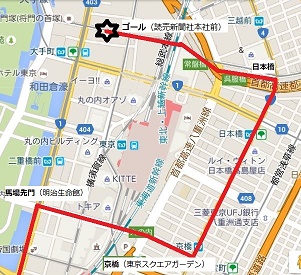
Last year's Hakone Ekiden has been reported in detail by correspondent Tataro Edo with photos (/archive/2015/01/post-2270.html).
Monument of the birthplace of Juntendo
Location 2-6-8, Higashi Nihonbashi, Chuo-ku, 103-0004, Japan (Yagenbori Fudoin precinct)
[Monument of the birthplace of the Central Commercial School]
Location 1-32, Shinkawa, Chuo-ku, 104-0033, Japan (in Shinkawa Park)
[Monument of Aoyama Gakuin Memorial Land]
Location 6-26 Akashicho, Chuo-ku, 104-0044, Japan (in front of Nichirei Akashicho Building)
[Nojinya]
December 28, 2015 17:00
I will go to Yagenbori (Higashinihombashi) for coverage of another article (the birthplace of Juntendo). Although Yagenbori is in the same Chuo Ward, it is a bit far from the house and it may be difficult to go on the subway, so I did not extend much so far, but this year there is a strong ally `` Community Cycle (CCC ) '' It is safe because there is. ) '' It is safe because there is.
When I entered the side street to park my bicycle at the port of the Industrial Hall (A04), Japanese lantern was displayed and opened in a fair state, just before Yagenbori Fudoin. Yes, the annual payment year-end market, Dekoichi, was open. 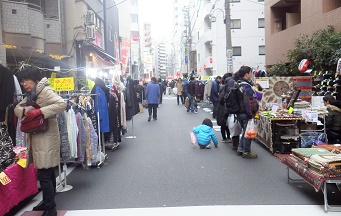 Of course, this is the first time that you have come to Yagenbori's year-end market, but you can see stalls selling women's clothing, shoes, bags, etc. Yokoyamacho is also nearby and is it a local character? Of course, this is the first time that you have come to Yagenbori's year-end market, but you can see stalls selling women's clothing, shoes, bags, etc. Yokoyamacho is also nearby and is it a local character?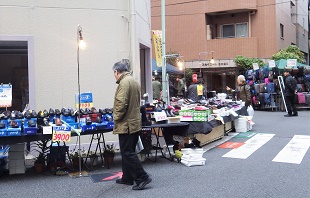
In Hong Kong and Taiwan, the night market fair, which is opened by shutting out a car completely out of the road, is not uncommon, but in Tokyo (although I may not just know), it was very fresh. It's fun to walk around.  The three-color lanterns are beautifully decorated, so when you look at them, it says "Daihonzan Kawasakidaishi". Yagenbori Fudoin is a temple of Shingon sect, so I looked into it while thinking that it might be a lineage of Mr. Kobo Daishi, and this is a Tokyo Betsuin of the Shingon sect Chizan School Daihonzan Kawasakidaishi Hirama-ji Temple, along with Meguro Fudo and Mejiro Fudo, it seems to be known as one of the three Edo Ofudos. The three-color lanterns are beautifully decorated, so when you look at them, it says "Daihonzan Kawasakidaishi". Yagenbori Fudoin is a temple of Shingon sect, so I looked into it while thinking that it might be a lineage of Mr. Kobo Daishi, and this is a Tokyo Betsuin of the Shingon sect Chizan School Daihonzan Kawasakidaishi Hirama-ji Temple, along with Meguro Fudo and Mejiro Fudo, it seems to be known as one of the three Edo Ofudos.
Since I'm studying hard, the ghost skin will peel off any more, so for details, a local correspondent, Tachibana's article in December last year, "Yagenbori Toshinoichi and Odekoichi (/archive / 2014/12/post-2264.html) ".
"Why is the old city opened at this time (the origin of the name of the old city of payment)" and "Why do you sell clothing and shoes here?" I am.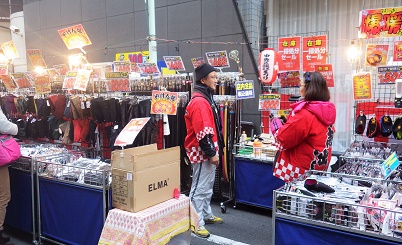
This year's old city, we are doing it until the 29th (Tuesday) this year.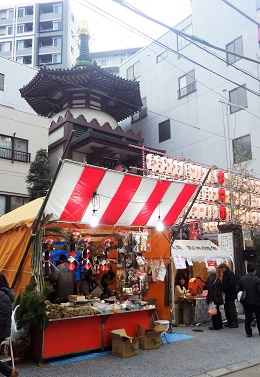
[A year old city of Yagenbori Fudoin]
Venue: Higashi-Nihonbashi 2-chome (around Yagenbori Fudoin)
Due date: December 27 (Sun)-29 (Tue)
Time: 11:00~19:00
[Nojinya]
December 28, 2015 12:00
How many more sleeps are New Year's Day. 。 。
Blog readers, are you ready for New Year's cards? Next year is the year of the monkey. "Shin" seems to mean "the fruit will mature and become clear", and next year seems to be "the year when the results of efforts will be fruitful." I want to do my best positively.
Well, just before I went to Kyobashi for dinner with my family, I went to a post office near the restaurant to buy a plain inkjet New Year's card while talking about such things.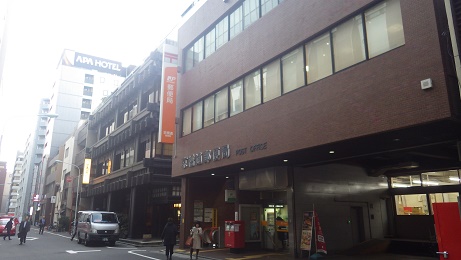
[Kyobashi-dori Post Office in Kyobashi]
There were many people at the post office seeking New Year's cards in the same way, so if you wait for your turn, the son of the "question kid " "  will ask simple questions as usual. will ask simple questions as usual.
"This post office is called Kyobashi-dori, but before this, there was an absence delivery slip in my home, and it was Kyobashi Post Office that went to receive a parcel from my aunt. I know "Kyobashi-dori Post Office" in Kyobashi, but why is that (of Harumi-dori St.) not "Tsukiji Post Office" but "Kyobashi Post Office"?"
~ Kyobashi-dori Post Office is a post office located a little on the road opposite Tokyo Square Garden across Chuo-dori toward Showa-dori. This street is between Kajibashi Street and Kyobashi Takegashi Street, and it seems that this area was once called Guashicho, Minami Temmacho, etc., but there is no particular street name at present ~~
"Yes, this Kyobashi-dori Post Office means a post office in Kyobashi. I wondered if the name of the street in front of me could be called "Kyobashi Street", but it doesn't seem to be particularly named on the street. " 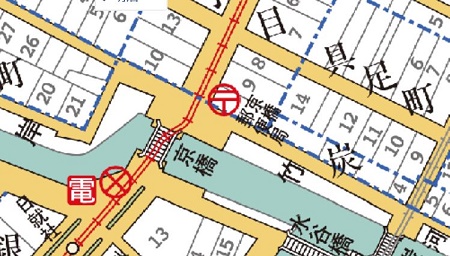 [Goo Map near Kyobashi in Meiji period] ⇒A little north of Kyobashi in the center, "Kyobashi Post Office (the predecessor of the current Kyobashi Dori Post Office?) You can see it. [Goo Map near Kyobashi in Meiji period] ⇒A little north of Kyobashi in the center, "Kyobashi Post Office (the predecessor of the current Kyobashi Dori Post Office?) You can see it.
~-I asked the Japan Post General Affairs Department about the origin of Kyobashi-dori Post Office. Kyobashi-dori Post Office was at the beginning of Showa (1929?) It was said that it was founded, but unfortunately the origin of the name was not known at the post office. On the other hand, if you look at the old map of Meiji period (goo map old map), you can see that there was a slightly smaller post office called Kyobashi Post Office near Kitazume in Kyobashi. It's just an estimate, but this post office also started as a Kyobashi post office, but it's confusing that there are two post offices with the same name, so at the beginning of Showa (near Kyobashi) "Kyobashi-dori Post Office" Isn't it that you changed the name (if you know about this point, I would be grateful if you could tell me more, and I would like to investigate it with the question monk.) ~ 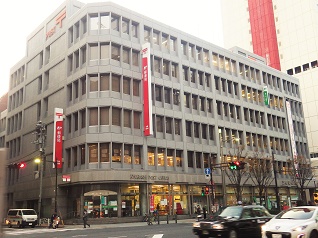 [Kyobashi Post Office along Harumi-dori St.] [Kyobashi Post Office along Harumi-dori St.]
「。 。 。 "Kyobashi Post Office" may have meant the post office of "Kyobashi Ward" when Chuo-ku was a separate ward in Kyobashi Ward and Nihonbashi Ward in the past. This post office is still a large post office that collects and distributes, but since it has long been a post office that has been the center of this area (formerly Kyobashi Ward), it may have been named Kyobashi Post Office. "
If you look at the old map of Meiji period (goo map old map), you can see the name "Kyobashi Post Office" at the current location of Tsukiji 4-chome. Looking at the map of the early Meiji era (a map of another Ministry of Home Affairs, etc.), it has not yet become a post office because it has not yet become a post office for "Navy territory" or "Agriculture, Commerce and Industry Ministry Land". ) It is presumed that the Kyobashi Post Office was established in Japan. ~~
[Goo Map near Tsukiji in Meiji period] ⇒You can see the "Kyobashi Post Office" in the center of the left. The pink land at the lower right is Tsukiji Honganji Temple, and the red line is Toden.
"Hey, Kyobashi Ward is a cool name!"
"The current Chuo-ku was established in 1947, and I know that Kyobashi-ku and Nihonbashi-ku were together to form Chuo-ku. Now it is called Tokyo's 23 wards, but in the Meiji era there were 50 wards, the era of 100 wards (precisely, there were 11 and 103 small wards and called O ward small wards), the era of 15 wards, The era of the 35 wards and the number of wards have changed significantly. Kyobashi Ward and Chuo-ku were born in 1878 when they became 15 wards. "
"By the way, do you know that Chuo-ku has a deep connection with the history of postal mail in Japan? Nihonbashi was the first post office in Japan, and now it is called the Postal Services Agency at an external office of the Ministry of Internal Affairs and Communications, but the Ministry of Communications, which was the source of it, was able to go to Kibikicho (now Ginza Junior High School, Ginza Post Office) in Meiji period."
Just because the order of waiting here came, the story ended, but his son also seemed interested in the history of Chuo-ku and mail. It seems that you will go to the Kyobashi Library and the Postal Museum in Oshiage (Sumida-ku) during the winter vacation to check various things.
[Kyobashi-dori Post Office]
Location 3-6-3 Kyobashi, Chuo-ku, 104-0031, Japan
Phone: 03‐3561‐1086
Business hours From 9:00 to 18:00 (Saturdays and holidays)
[Kyobashi Post Office]
Location 4-2-2 Tsukiji, Chuo-ku, 104-8799, Japan
Phone: 03‐5546‐1068
Business hours From 9:00 to 19:00 (Saturday is ~ 17:00, Sundays and holidays ~ 12:30)
|
Links
|
 In front of main hall, Chinowa for New Year's Eve exorcism has already been prepared, and the part where shrine office was located remains surrounded by a white board, but as usual, this New Year seems to be safe.
In front of main hall, Chinowa for New Year's Eve exorcism has already been prepared, and the part where shrine office was located remains surrounded by a white board, but as usual, this New Year seems to be safe.
 [Tepposhu Inari Shrine]
[Tepposhu Inari Shrine]


 I'll go inside. The first and second floors are museum shops, providing information on museums in Europe, mainly in Louvre and France, as well as exhibiting and selling museum goods. It's not a very large space, but there are
I'll go inside. The first and second floors are museum shops, providing information on museums in Europe, mainly in Louvre and France, as well as exhibiting and selling museum goods. It's not a very large space, but there are 
 This is not limited to Europe such as France, but it is a place to disseminate graphic design, but it seems that activities in cooperation with MMM will also be carried out when reopening.
This is not limited to Europe such as France, but it is a place to disseminate graphic design, but it seems that activities in cooperation with MMM will also be carried out when reopening. On the road name information board outside the window, "Miyuki-dori (MIYUKI DORI)" is written, and
On the road name information board outside the window, "Miyuki-dori (MIYUKI DORI)" is written, and


 On the outbound route, start in front of the Yomiuri Shimbun headquarters in Otemachi, go straight south on Hibiya Street in Chiyoda-ku, but the last 10th ward on January 3 runs in Chuo-ku.
On the outbound route, start in front of the Yomiuri Shimbun headquarters in Otemachi, go straight south on Hibiya Street in Chiyoda-ku, but the last 10th ward on January 3 runs in Chuo-ku.



 Of course, this is the first time that you have come to Yagenbori's year-end market, but you
Of course, this is the first time that you have come to Yagenbori's year-end market, but you






 [Kyobashi Post Office along Harumi-dori St.]
[Kyobashi Post Office along Harumi-dori St.]

